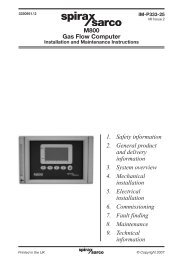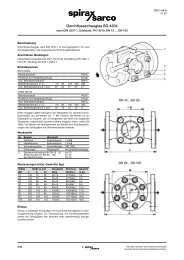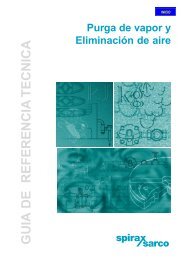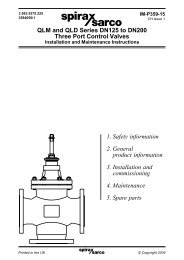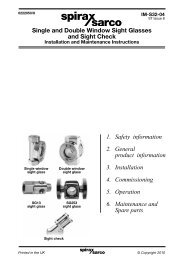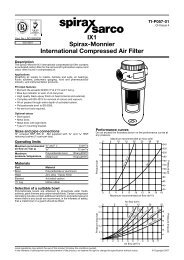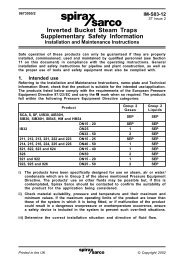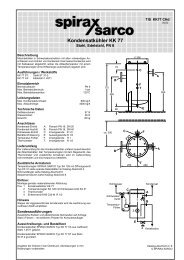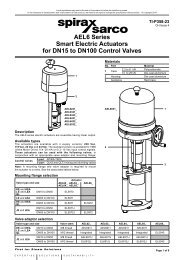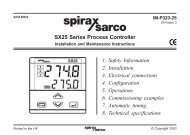2000 Hook-up Book - Spirax Sarco
2000 Hook-up Book - Spirax Sarco
2000 Hook-up Book - Spirax Sarco
Create successful ePaper yourself
Turn your PDF publications into a flip-book with our unique Google optimized e-Paper software.
Steam Quality<br />
vs. Steam Purity<br />
It is important to define the difference<br />
between steam quality and<br />
purity.<br />
Steam Quality— “The ratio of the<br />
weight of dry steam to the weight<br />
of dry saturated steam and<br />
entrained water. For example, if<br />
the quality of the steam has been<br />
determined to be 95%, the wetsteam<br />
mixture delivered from the<br />
boiler is composed of 5 parts by<br />
weight of water, usually in the<br />
form of a fine mist, and 95 parts<br />
by weight of dry saturated steam.<br />
Likewise, if the quality of the<br />
steam has been determined to be<br />
100%, there is no wet steam<br />
delivered from the boiler, 100% of<br />
the steam delivered from the boiler<br />
is dry saturated steam.”<br />
Steam Purity— “A quantitative<br />
measure of contamination of<br />
steam caused by dissolved solids,<br />
volatiles, or particles in vapour or<br />
by tiny droplets that may remain in<br />
the steam following primary separation<br />
in the boiler”.<br />
Plant<br />
Steam<br />
Condensate<br />
Pure/<br />
Clean<br />
Steam<br />
Generator<br />
Main drip<br />
traps for<br />
distribution<br />
system<br />
condensate<br />
removal<br />
Condensate<br />
Figure 56<br />
Clean/Pure Steam Generator and Distribution System<br />
Thus, the three different<br />
types of “clean” steam (filtered,<br />
clean and pure) can, and will,<br />
have different characteristics,<br />
summarized in Table 14.<br />
Note in particular that:<br />
1. The quality of filtered steam<br />
will normally be high because<br />
water droplets larger than the<br />
filter element rating will be<br />
removed. Clean and pure<br />
steam systems will have a<br />
quality related to the design<br />
and operating characteristics<br />
of the generator, length and<br />
installation details of distribution<br />
system, insulation of<br />
system, number and effectiveness<br />
of mains, drainage<br />
points, etc.<br />
Clean Steam<br />
Table 14: Differences in Steam Characteristics<br />
Quality Purity<br />
Particles Boiler Additives<br />
Filtered High Typically 2.8 microns Normally present<br />
Clean Varies on System Design Varies Limited to process<br />
Pure Varies on System Design Varies None<br />
Clean Steam<br />
Distribution Main<br />
Separators and<br />
filters for efficient<br />
conditioning of<br />
steam.<br />
Condensate<br />
Pure Water<br />
Hygienic ball valves<br />
for isolation on<br />
distribution systems.<br />
Regulators<br />
for accurate<br />
pressure control<br />
2. Boiler additives may well be<br />
present in filtered steam and<br />
also possibly in clean steam,<br />
but often this will be limited by<br />
process requirements. For<br />
example, the FDA restricts<br />
the use of certain additives,<br />
including amines, in any<br />
steam which comes into<br />
direct contact with foods or<br />
dairy products.<br />
3. Assuming the generating and<br />
distribution system have<br />
been designed and installed<br />
correctly, the particles present<br />
in a pure steam system<br />
will be water only. Dependent<br />
on feed water type, the same<br />
may also apply to clean<br />
steam systems.<br />
Process steam traps for<br />
effective contaminated<br />
condensate drainage.<br />
Process<br />
Vessel<br />
Condensate<br />
Diaphragm<br />
Valves<br />
51<br />
SYSTEM DESIGN



